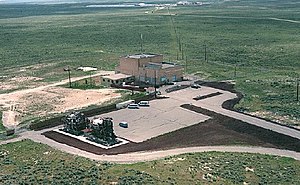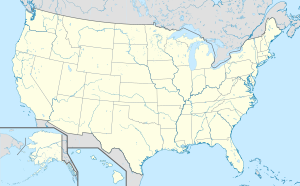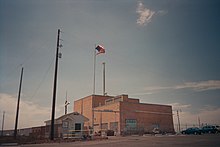Experimental Breeder Reactor I.
| Experimental Breeder Reactor I. | ||
|---|---|---|

The EBR-I today - there are two prototypes of a nuclear aircraft engine in the parking lot |
||
| location | ||
|
|
||
| Coordinates | 43 ° 30 ′ 41 ″ N , 113 ° 0 ′ 23 ″ W | |
| height | 1525 m | |
| country |
|
|
| Data | ||
| owner | US Department of Energy | |
| operator | National Reactor Testing Station | |
| start of building | October 10, 1950 | |
| Installation | August 24, 1951 | |
| Shutdown | Early 1964 | |
| Reactor type | Breeder | |
| Thermal performance | 1,200 kW | |
| was standing | February 2, 2009 | |
The Experimental Breeder Reactor I ( EBR-I ) at the Idaho National Laboratory was an experimental reactor that was the world's first nuclear reactor to generate electricity on December 20, 1951 , as well as the first functioning breeder reactor . Several other technologies were also implemented for the first time in this reactor. Operated until 1963, it is now a National Historic Landmark and is open to visitors.
The facility in the south of the US state of Idaho is located between Idaho Falls and Arco . The construction was designed from 1946 under the direction of Walter Zinn and with the participation of Enrico Fermi at the Argonne National Laboratory , released in 1947 by the Atomic Energy Commission and built from 1949 on a new test site in the semi-desert Idaho. Its purpose was to demonstrate power generation and further nuclear research. The reactor core was exchangeable, the two coolant circuits , the primary circuit and the secondary circuit, were operated with the liquid sodium-potassium alloy NaK . The secondary circuit transferred its energy in a heat exchanger to a water-steam circuit that drove a conventional combination of turbine and generator .
In August 1951, a first attempt failed because the amount and density of fuel was insufficient to produce a critical mass . In December of the same year, a small amount of electrical power could be delivered for the first time after the core was converted. On the first day, the power was sufficient for the needs of four light bulbs , from the next day and until it was decommissioned, the system generated enough power for its own use and various research tasks. In 1953, the breeding process, which had only been predicted theoretically until then, could be demonstrated in the EWC-I for the first time .
During its lifetime, the reactor was operated with four different reactor cores. The first consisted of only 52 kg of highly enriched uranium in a very dense structure for the time. The nuclear fuel of the next two was enriched uranium combined with 2% zirconium . During the operation of the second core, there was a partial core meltdown in 1955 , the effects of which were limited to the core itself. The last reactor core from November 1962 was made of plutonium , making the EBR-I the world's first reactor to generate electricity from the fission of plutonium. This last reactor core, known as the Mark IV, also produced more fuel than it split for the first time with a breeding rate of 1.27.
The reactor was shut down in early 1964 and replaced by the neighboring Experimental Breeding Reactor II . In 1966 the facility was designated a National Historic Landmark . It is listed on the National Register of Historic Places. Since 1976 - after all radioactive installations were removed - it has been open to the public as a museum in the summer half-year. In the parking lot in front of the building are two prototypes built by General Electric for a nuclear aircraft engine .
Web links
- Argonne National Laboratory: A Brief History of Materials R&D - contains technical details about the EBR-I and its reactor cores
- Report on EWC-I from 1996
- Reactors Designed by Argonne National Laboratory: Fast Reactor Technology (English)
- Idaho National Laboratory: EWC-I Factsheet (English; PDF; 1.5 MB)
Individual evidence
- ↑ Idaho National Laboratory: EBR-I Factsheet (PDF; 1.5 MB)
- ↑ Listing of National Historic Landmarks by State: Idaho. National Park Service , accessed July 22, 2019.
- ↑ Experimental Breeder Reactor No. 1 in the National Register Information System. National Park Service , accessed August 9, 2017.



